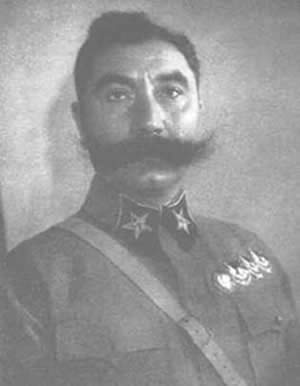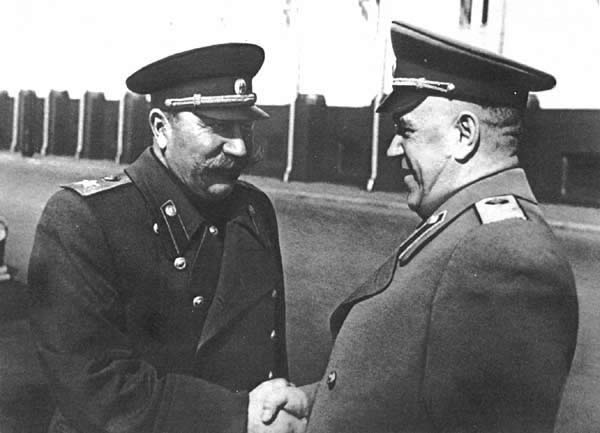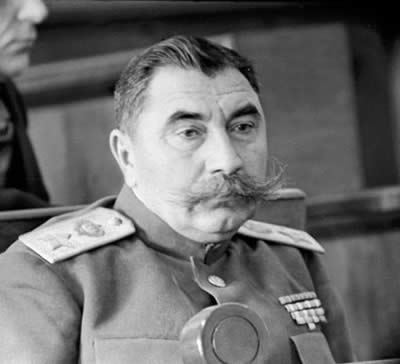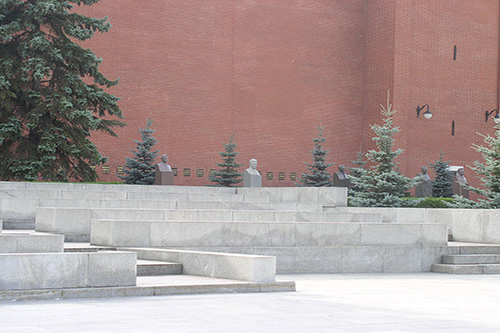Semyon M. Budyonny
Semyon Mikhailovich Budyonny was born April 25 1883 in a small Cossack village in the vicinity of Kuban in the Caucasus. He started his military career in the Czarist army. He served in the cavalry during the Russo-Japanese war of 1905. When Russia got involved in World War One, Budyonny was placed in command of a cavalry brigade in the Czarist Army.
When the October revolution erupted in 1917, Budyonny joined the Red Army and was put in command of a cavalry division. He distinguished himself in the ensuing battles and was promoted to commander of the 1st Cavalry Corps with which he was very successful against the Whites as well during the Russian Civil War. Owing to his achievements during this bloody civil war, Budyonny became a living legend. This was enhanced even more by propaganda in the Soviet Union which continued glorifying these achievements for dozens of years.
For his services during the fighting in Russia, Budyonny was placed in command of the famous 1 Cavalry Army that fought against Poland in 1920. Despite the fact that the Red Army was not very successful in this war, Budyonny did prove himself a master in mobile warfare (with cavalry units, that is). After the war Budyonny joined the Communist Party, was admitted to the Central Committee in 1920 and became active politically.
In 1923 Budyonny, who was adored by his troops, became inspector of cavalry. During the interbellum, Budyonny was in command of various military districts, including that of the Northern Caucasus (Stalingrad) and Moscow. On November 20, 1935, Budyonny, Kliment Y. Voroshilov (Bio Voroshilov), Tukhachevsky, Blyukher and Yegorov were all promoted to Marshal of the Soviet Union but in 1937 Joseph V. Stalin (Bio Stalin) started purging the top echelon of the Red Army. Budyonny and Voroshilov had always been very loyal to Stalin and so they were the only two out of the five marshals who survived the purges. Budyonny’s role in this is questionable. Some sources state he actively cooperated in selecting suspected officers, others claim he did everything in his power to prevent the liquidations. Whatever the case, Budyonny was saved and when war with Germany loomed, he was named deputy People’s Commissioner of Defense under Marshal Voroshilov.
When it became evident the Germans were focusing their attention on Russia, Budyonny was placed in command of the southern strategic axis on the western border of the Soviet Union, making him responsible for the mobilization and the actions of the military districts of Kiev and Odessa, renamed the Southwestern front and the Southern front respectively on June 22, 1941.
When Operation Barbarossa was unleashed on June 22, 1941, the Southwestern front commanded by Colonel-general Mikhail P. Kirponos (Bio Kirponos) and the Southern front commanded by Colonel-general Tyulenev managed to delay the advance of the German Heeresgruppe Süd commanded by Feldmarschall Von Rundstedt (Bio Von Rundstedt). The armored divisions of Heeresgruppe Mitte had to come to his aid in order to encircle the Southwestern front. This caused the encirclement of Budyonny’s forces near Kiev. The largest defeat in military history up till then became a fact when the surrounded forces surrendered on September 1941. Over half a million Soviet military were taken prisoner. Budyonny however was highly regarded by Stalin who had him flown out of the pocket before the troops in there had surrendered. Nonetheless, Stalin relieved him of his function and he was replaced by Marshal Semyon K.Timoshenko (Bio Timoshenko).
Budyonny was given a new function soon. He was named commander of the Reserve Front that was charged with the defense of the approaches to Moscow along with the Briansk front and the Western front. When Operation Typhoon set in, the Reserve front was completely overrun within a few days and once again, hundreds of thousands Russian soldiers were surrounded, Budyonny however managed to escape the encirclement. Command of the Reserve front was to be Budyonny’s last posting as a field commander though.
Budyonny was a unique personality. He wore a big moustache and he habitually carried two revolvers with mahogany grips on his belt. He displayed the same boisterous behavior as American general George Patton (Bio Patton). Patton however was a an ambitious leader of men and that could by far not be said of Budyonny. He was a cavalry man of the old school who still used the tactics from the Russian civil war on the battlefields of 1941. In the face of a modern fighting machine like the German Wehrmacht, these tactics were utterly useless. It must be said however that during the battle of Kiev, Stalin had ordered Budyonny personally he was not allowed to withdraw his troops. Within the Red Army, a new generation of commanders such as Georgi K. Zhukov (Bio Zhukov), Ivan S. Konev (Bio Konev) and Konstantin Rokossovski (Bio Rokossovski) had emerged to replace commanders like Kliment Y. Voroshilov and Budyonny.
Following the disastrous defeats, Budyonny was appointed to command education and training of the recruits of the cavalry units. He was given this task because due to the rapid expansion of the Red Army, the recruits were utterly inexperienced in military matters. As the Red Army suffered from a severe shortage of tanks and trucks in the winter of 1941 to 1942, the cavalry was called upon once more to execute mobile operations, hence Budyonny was given the task to make the training more intense. In addition, Budyonny held a number of ceremonial functions and hence attended the various military parades on the Red Square in Moscow.
He held his position of inspector of cavalry until his retirement in 1954. Marshal Budyonny passed away on October 27, 1973 in Moscow.
Definitielijst
- brigade
- Consisted mostly of two or more regiments. Could operate independently or as part of a division. Sometimes they were part of a corps instead of a division. In theory a brigade consisted of 5,000 to 7,000 men.
- cavalry
- Originally the designation for mounted troops. During World War 2 the term was used for armoured units. Main tasks are reconnaissance, attack and support of infantry.
- Heeresgruppe
- The largest German ground formation and was directly subordinate to the OKH. Mainly consisting of a number of “Armeen” with few directly subordinate other units. A Heeresgruppe operated in a large area and could number several 100,000 men.
- interbellum
- “Latin: Between war”. Years between the Great War and World War 2.
- Marshal
- Highest military rank, Army commander.
- mobilization
- To make an army ready for war, actually the transition from a state of peace to a state of war. The Dutch army was mobilized on the 29 August 1939.
- Odessa
- Organisation of Former SS-members. Secret organization of and for former SS-members. Organised new identities and housing abroad after the war.
- propaganda
- Often misleading information used to gain support among supporters or to gain support. Often used to accomplish ideas and political goals.
- Red Army
- Army of the Soviet Union.
- revolution
- Usually sudden and violent reversal of existing (political) the political set-up and situations.
- Soviet Union
- Soviet Russia, alternative name for the USSR.
- Wehrmacht
- German armed military forces, divided in ground forces, air force and navy.
Images
Information
- Article by:
- Tom Notten
- Translated by:
- Arnold Palthe
- Published on:
- 19-01-2025
- Feedback?
- Send it!
Related sights
Related books
Sources
- CLARK, A., Barbarossa, Cassell Military Paperbacks, Londen, 2001.
- ERICKSON, J., The Road to Stalingrad, Weidenfeld and Nicolson Ltd., Londen, 1983.








